
"The Power of Art: The Depiction of Power and Legitimacy in Official Portraits of Kings, Presidents, and Prime Ministers"(May, 2025)
By David M. Hart
 |
|---|
| Cyril Bouda (1956) |
[Created: 5 May, 2025]
[Updated: 5 May, 2025] |
Introduction
This talk was given to a meeting organised by the University of the Third Age (U3A) on 7 May, 2025, in Newport, Sydney.
Table of Contents
SUMMARY↩
Iconography of Power
Events where symbols of power and legitimacy are depicted:
- coronations
- Jubilees of rule
- deaths
- public memorials, statues, ceremonies (ANZAC Day)
Today I want to focus on official portraits of political leaders:
- created at the time of their coronation (kings and emperors)
- or election to office (presidents and prime ministers)
Two common themes:
- the continuity of the symbols of power and authority which have continued over the centuries
- adopted by monarchs, emperors, presidents, and prime ministers
- purpose and meaning
- the “majesty” of high office - awe inspiring
- claim to legitimacy via God, the military, justice
- in modern period - “service” to the people - the hard working leader dedicated to serving the people, at work in his office
- who sees these symbols?
Symbols of Power and High Office
- majesty, link to God, link to military, link to justice
- the hard working leader dedicated to serving the people - at work in his office
Some historical examples which set the example
- European Monarchs - divine right of kings
- Louis XIV
- Charsles I, Charles II, C Charles III
Leaders who rule in the name of the people
- George Washington
- Emperor Napoleon
Later examples:
- American Presidents
- other US presidents
- Trump
- Australian Prime Ministers
The Coronation of Kings↩
- The symbols of royal authority and legitimacy
- Anthony van Dyck, "Charles I (1600-1649) in robes of state" (1636)
- John Michael Wright, “The Coronation Portrait of Charles II” (c. 1671-76)
- Hyacinthe Rigaud, "Portrait of Louis XIV in Coronation Robes" (1701)
- Hugo Burnand, "The official portraits from The Coronation of Their Majesties The King and Queen" (8 May, 2023).
The Symbols of Royal Authority and Legitimacy↩
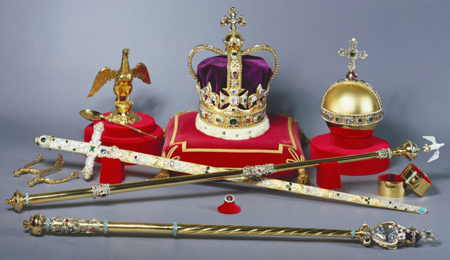
The Sovereign's Orb
- symbol dates back to Henry II Holy Roman Emperor 1014
- sphere with a cross on top; divided into 3 sections representing the known world at the time; symbol of the king's rule over the Christian world; this one made in 1661 for KC2
The Sovereign’s Sceptre with Cross
- another symbol of king's temporal power under the dominion of god (the cross at the top)
- richly covered in jewels
The Sovereign’s Sceptre with Dove (the Rod of Equity and Mercy)
- dove is the symbol of the Holy Spirit
- symbol of king's spiritual power
The Ampulla and Coronation Spoon
- golden Ampulla is shaped like an eagle (royal symbol) with its wings spread
- scented holy oil which has been consecrated in the Church of the Holy Sepulchre in Jerusalem from a centuries-old recipe; the Archbishop of Canterbury will pour the oil (from the eagle's beak) into the spoon and then onto the the king behind a screen hiding them from public view
The Crown Jewels
- St. Edward's Crown: worn by all the royals going back to KC2 1661; used in the actual coronation
- The Sovereign’s Ring, Spurs, Glove
The Royal wardrobe
- the crimson Robes of State to enter Westminster Abbey
- the plain Colobium Sindonis Robes to undergo the anointing in a humble state
- the golden silk Supertunica for the investiture ceremony
- the Robe Royal for the crowning
- the Robe of Estate (6.5 meters long and 15 pounds) of purple velvet trailing, to exit the abbey
Anthony van Dyck, "Charles I (1600-1649) in robes of state" (1636)↩
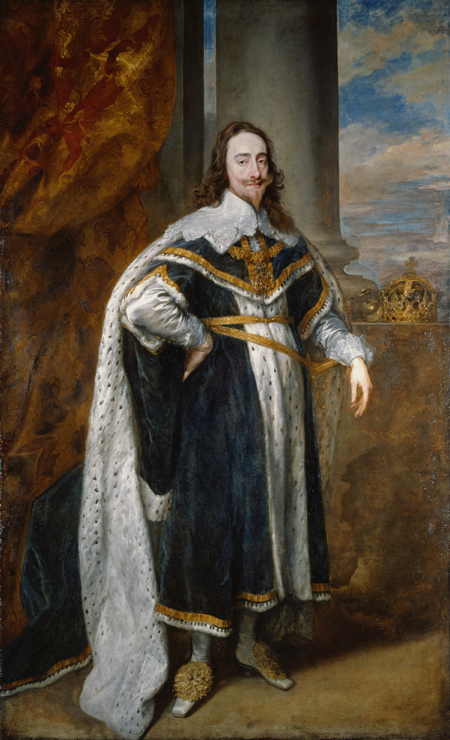
[See a larger version of this image (900px).]
Painting
Commissioned by Charles I and painted by Anthony van Dyck (1599-1641), possibly as an official state portrait. It was copied several times and was often hung with a picture of the Queen.
Source
It is owned by the Queen's Gallery, Windsor Castle. Website: The Royal Collection Trust. "Explore the Royal Collection" [Online elsewhere].
Description
King Charles I (1600-1649) - reigned 1825-1649 (executed by beheading).
He is standing in front of a Roman/Greek column and a heavy red and gold curtain. In the distance we see a blue sky with clouds. He is facing the viewer, dressed in royal robes (navy and gold) and a white ermine cloak. His left elbow is resting on a table with his crown and orb which are not prominently displayed (by being on his head or in his hand), and his right arm is on his hip. His robe is long and ends just above his ankles. His shoes are silver and have an elaborate gold buckle. Since Charles was quite short van Dyck was able to hide this fact as there is neither to provide any scale in the picture, although the table seems to be quite high for his elbow.
KC1 and the Divine Right of Kings
KC1 firmly believed in the divine right of kings to rule over their subjects. His conflict with Parliament over funding/taxes for his military activities and his repression of religious dissent led to a series of civil wars in the 1642, his defeat in battle and arrest, and ultimately execution in a Revolution against his rule, and the creation of a republican "Protectorate" under Oliver Cromwell. Another Stuart was "restored" to the monarchy in 1660 (Charles II).
While he was in prison awaiting execution he wrote a book to defend his rule and his divine right to rule, a thing which was most unusual for a sitting monarch to do.
Εἰκὼν Βασιλική (the Image of the King), The Pourtrature of His Sacred Majestie in His Solitudes and Sufferings (1649)
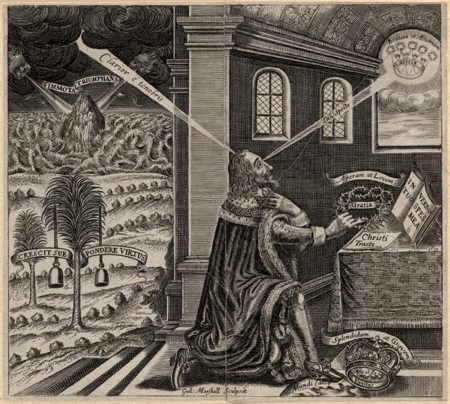
In this book there is a frontispiece which provides an interesting glimpse into his political thinking. He seems to believe that:
- he was sent by God to earth to be the King of England;
- like a "rock" he endured many political storms and hardships - the weights hanging from the tree (seen on the left of the panel) - but lost the battle;
- he is kneeling before an altar-like table with his earthly crown knocked to the ground at his feet (one of three crowns in the right side of the panel)
- he is holding another crown - this time the crown of thorns like Christ had to wear while carrying the cross on which he would be crucified
- he is looking up to heaven where he sees his heavenly crown waiting for him
These claims were criticized by an anonymous author in a book called Eikon alethine (The True Ikon or Image) which had an image called "“Spectatum admissi risum teneatis” (If you saw such a thing, could you restrain your laughter - a quote from Horace, Ars Poetica V) which shows a cleric who had been hiding behind a curtain which has been pulled back by a hand reaching down from above.
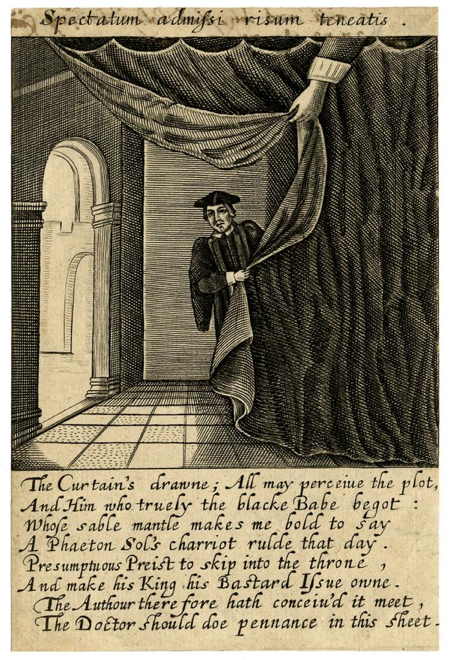
The poem below the image states:
The Curtain’s drawne; All may perceive the plot,
And Him who truely the blacke Babe begot:
Whose sable mantle makes me bold to say
A Phaeton Sol’s chariot ruled that day.
Presumptuous Priest to skip into the throne,
And make his King his Bastard Issue owne.
The Author therefore hath conceiv’d it meet,
The Doctor should doe pennance in this sheet.
The poet John Milton also wrote a criticism of the book and the ideas off divine right of monarchs in two tracts
- John Milton, EIKONOKLASTES In Answer To a Book Intitl’d EIKON BASILIKE, The Portrature of his Sacred Majesty in his Solitudes and Sufferings (1649) [Online]
- John Milton, The Tenure of Kings and Magistrates: Proving, That it is Lawfull, and hath been held so through all Ages, for any who have the Power, to call to account a Tyrant, or wicked KING, and after due conviction, to depose and put him to death; if the ordinary MAGISTRATE have neglected or deny’d to doe it. And that they, who of late, so much blame Deposing, are the Men that did it themselves (1649) [Online]
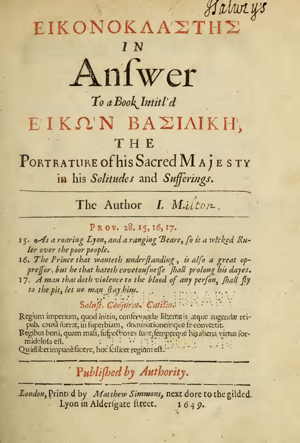 |
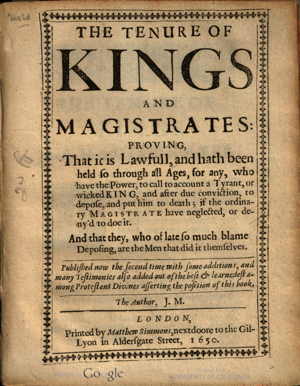 |
|---|
See Charles Stuart (King Charles I), Eikon Basilike, or the King’s Book. Edited by Edward Almack F.S.A. (Alexander Moring Limited. The De La More Press, London, 1904). [Online]
And my essay on "Making and Breaking the Image of King Charles I" (27 May, 2021) [Online]
John Michael Wright, “The Coronation Portrait of Charles II” (c. 1671-76)↩
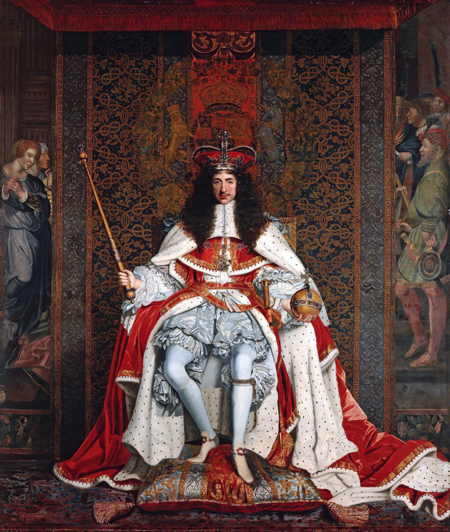
[See a larger version of this image (1268px).]
Painting
John Michael Wright (1617-1694), “The Coronation Portrait of Charles II” (c. 1671-76).
Source
The Royal Collection Trust, ion the Throne Room, Palace of Holyroodhouse. [Online elsewhere].
Description
King Charles II (1630-1685) - reigned 1660-1685.
His coronation was in Westminster Abbey 23 April, 1661. The king was 31 years old.
The king is sitting down in a very formal and symmetrical pose which shows the large size of his robe which is laid out around him. he looks both stern and confident. He is siting in front of a large embroidered canopy which shows the royal coat of arms. Behind this is a half obscured tapestry which depicts the "Abduction of Romulus and Remus" (a mythical story about the founding of Rome in which the children are saved from death by divine intervention).
On his head he is wearing a large periwig on top of which is the Crown of State. Around his neck is the Garter Collar and the Great George medal. In his hands he is holding the Orb and Sceptre which were remade for the occasion as they had been destroyed after the fall of Charles I. At his side he has a sword.
The robe is made of crimson red silk velvet lined with ermine. Underneath the robe he is wearing the costume of the Order of the Garter which is made of sliver cloth. His sleeves have double cuffs of lace, and his voluminous petticoat breeches has rows of ribbon loops. His white stockings also have garters with loops of ribbons. On his feet are red high heeled shoes with bejeweled buckles. His feet are resting on an ornate pillow so that they do not touch the floor.
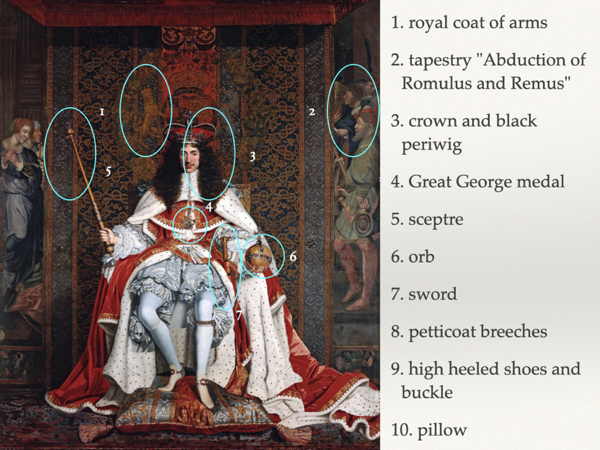
Hyacinthe Rigaud, "Portrait of Louis XIV in Coronation Robes" (1701)↩

[See a larger version of this image (1390px).]
Painting.
"Portrait of Louis XIV in Coronation Robes" (1701) by Hyacinthe Rigaud (1659-1743). In the Louvre Museum, Paris.
Source
Wikipedia: [Online elsewhere]
Description
Louis XIV (1638-1715) - reigned 1643/1661-1715.
Painted in 1701 when he was 63 and at the height of his power. His coronation was in 1654 (age 16). So the painting is a "reimagining" of the event many decades later.
The king is standing in a fairly casual fashion, turned slightly to the side, with one hand on his left hip (near his sword - the sword of Charlemagne), the right hand is holding the sceptre (upside down; it used to belong to his grandfather Henry IV) like a walking cane, his cloak has been lifted up to reveal his legs (which look like they belong to a much younger man - he was a keen dancer in his youth). He stands in the centre comprising one vertical image between a marble column to the left and his throne to the right). The pillar stands on a base with reliefs: at the front is an allegory of Justice, and to the left Strength (mostly hidden). He is not sitting on the throne (which was customary in these pictures) which stands behind him and slightly raised. He seems to have a look of disdain, holding the sceptre upside down without wearing a glove (which he is holding in his left hand), and is not wearing his crown (which is the side table) or holding the hand of justice (also on the side table). The throne is upholstered in blue with gold fleurs-de-lys (a symbol of royalty). The outside of his cloak, the side table, and cushion are also blue with gold fleurs-de-lys. The inside of his cloak is black and white ermine fur. Above him is a bright red and gold silk curtain which has been lifted aside to reveal what is not normally seen by the public. He wears a very large black periwig which was the fashion, a lace shirt with elaborate cuffs, brocade breeches, red high heeled shoes (he was quite short) with diamond buckles, silk stockings held up by garters. Around his neck is a chain of the Order of the Holy Spirit.
- silk canopy or curtain which is lifted aside to reveal what is not normally seen
- the black periwig
- the throne in blue and gold fleurs-de-lys
- his ermine coronation robe
- the sword of Charlemagne
- silk stockings, garters, and high heeled red shoes
- a marble column
- an allegory of Justice
- the sceptre (upside down)
- the crown and hand of justice
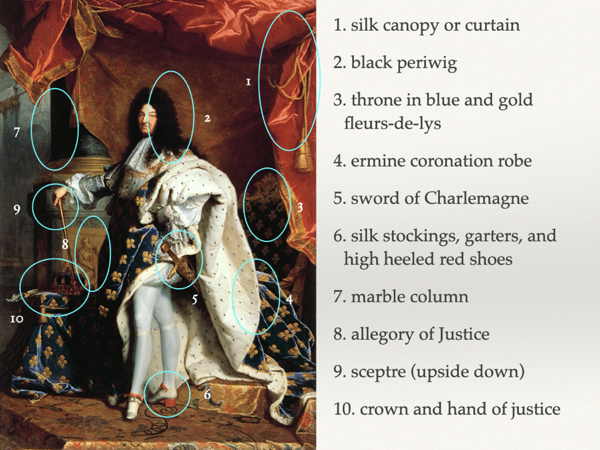
Official Portraits of King Charles III↩
Hugo Burnand, "The official portraits from The Coronation of Their Majesties The King and Queen" (8 May, 2023).
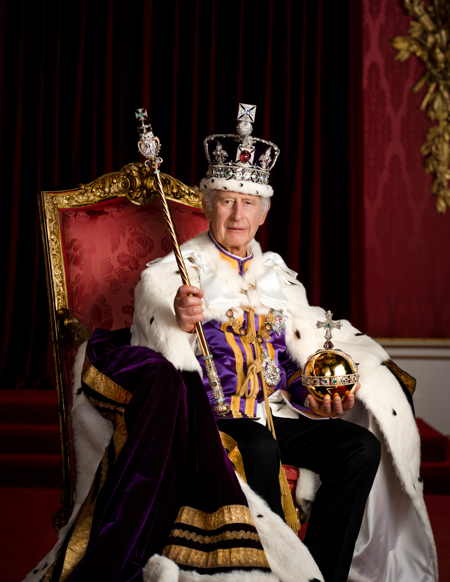
[See a larger version of this image (900px).]
Photograph
Hugo Burnand, "The official portraits from The Coronation of Their Majesties The King and Queen" (8 May, 2023).
Source
The Royal Website [Online elsewhere]
Description
The description comes from the Royal website:
His Majesty is pictured in full regalia in the Throne Room at Buckingham Palace. His Majesty is wearing The Robe of Estate, The Imperial State Crown and is holding the Sovereign’s Orb and Sovereign’s Sceptre with Cross. His Majesty is seated on one of a pair of 1902 throne chairs that were made for the future King George V and Queen Mary for use at the Coronation of King Edward VII. These throne chairs were also used in the background of the 1937 Coronation of King George VI and Queen Elizabeth and by His Majesty The King Charles III and Queen Camilla at Westminster Hall to receive addresses from the Speakers of both Houses of Parliament last year.
Official Photograph by Hugo Burnand↩
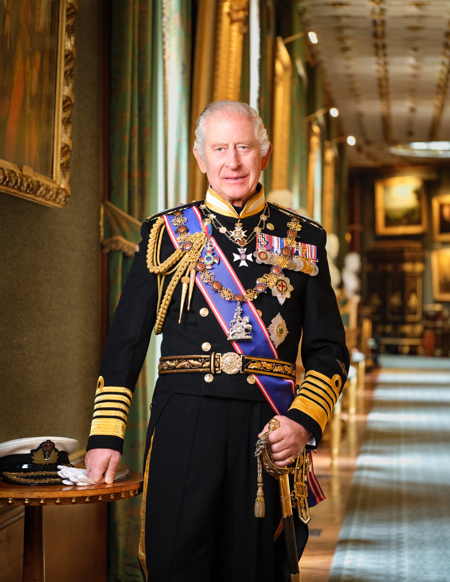
Source
Photograph by Hugo Burnand of KC3 in his naval military uniform. Multiple sources on the web.
Description
Commissioned by the UK government to be used in public buildings, schools, hospitals, etc. and distributed at a cost of £8 million.
KC3 is wearing the uniform of the Admiral of the Fleet (No. 1 Tailcoat), on which is hung the Garter Collar and Sovereign’s badge and Garter Star, his Thistle Star, the Bath Sovereign’s badge, his Order of Merit, the Royal Victorian Order’s Royal Victorian Chain and GCVO Sash, as well as many medals on his medal bar.
Official Portrait commissioned by KC3↩
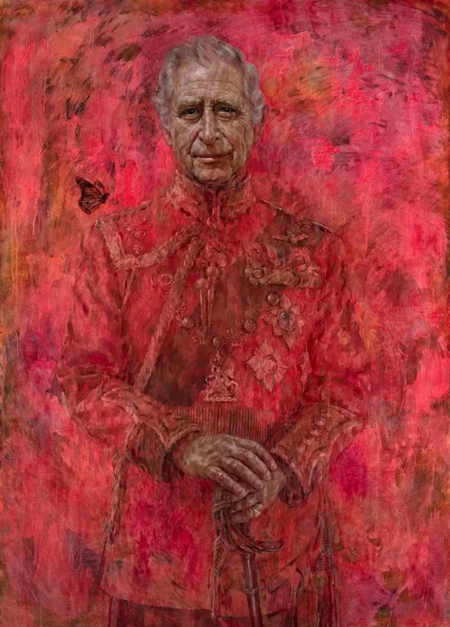
[See a larger version of this image (900px).]
Source
Katie Razzall, "King Charles: First official portrait since coronation is unveiled, painted by Jonathan Yeo", BBC (15 May, 2024). [Online elsewhere]
Description
Painted on a large canvas (8ft 6in by 6ft 6in) which shows him larger than life size. The king is wearing the red coat of the Welsh Guards of which he was made regimental colonel in 1975 (at the age of 27), over which hangs the chain of the Order of the Garter and several medals. He is not wearing any royal insignia as the painting concerns his position as patron (for over 50 years) of the Most Worshipful Company of Drapers which dates back to the medieval period. His mother QE2 had also been a member of the Drapers dating back to 1947.
His face and hands stand out from the red wash which covers the painting. Note the Monarch butterfly on his right shoulder, which might be a reference to nature or perhaps cancer?
Official Portraits of Emperors and Presidents↩
Introduction↩
There are some striking parallels in the lives of George Washington (1732-1799) and Napoléon Bonaparte (1769-1821): both were military leaders who helped their countries during a revolution and both came to power as head of a republic which had shaken off the shackles of monarchy. But whereas Washington was content to return to civilian life and promote the development of the new republican institutions of the U.S., Napoleon sought to centralize power in his own hands as First Consul and then as a self-crowned Emperor of the French. The former remained a staunch republican whilst the latter turned into a military tyrant. Washington in his "Farewell Address" of 1796 warned of the dangers to the new republic of trying to behave like a traditional European power with "entangling alliances" which would suck it into wars and international conflicts. Napoleon on the other hand sought to use military force to "free" Europe from "feudalism," from Spain in the west to Russia in the east. Possibly by the time the portrait of Napoleon was painted (some 8 years after the events depicted in the painting took place) he sensed that his imperial ambitions might lead to naught and that his most enduring legacy would be the legal reform he introduced with the Civil Code.
Gilbert Stuart, George Washington (1796) (“the Lansdowne Portrait”)↩
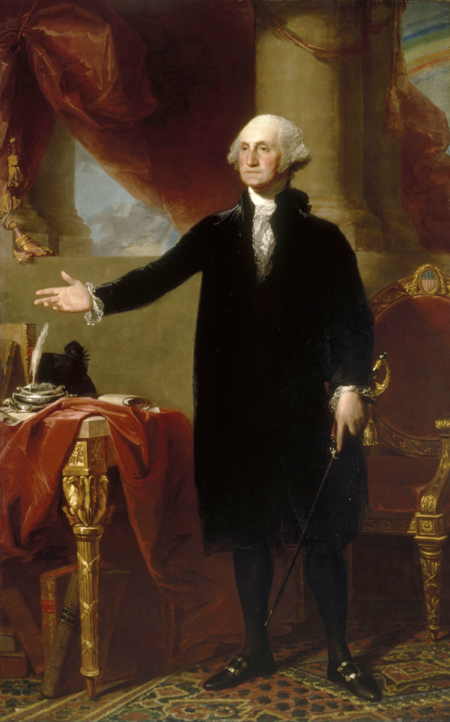
[See a larger version of this image (900px).]
Painting
Gilbert Stuart, George Washington (1796) (“the Lansdowne Portrait”).
Source
National Portrait Gallery, Smithsonian Institution, Washington, D.C. [Online elsewhere]
Description
Washington served as the first president of the United States from 1789 to 1797 which means that this painting was made towards the end of his period in office. Washington is dressed in a black velvet suit with a white shirt, black stockings, and black shoes with gold buckles. He is standing on a large woven carpet and is not smiling and has a expressionless face. In his left hand he is holding a sword; his right arm is outstretched in a welcoming gesture. Behind him to the right is a red upholstered chair with the oval-shaped image of the American stars and stripes, a version of which appears in the Great Seal of the United States (1782). To the left is a table with a red cover which has been lifted up in one corner to reveal 5 large books on the floor suggesting he has been at work. Two more books are on the table next to a quill pen and ink, some rolled up papers, and a black feathered hat. The lifted up table cloth also shows the table leg in the shape of Roman fasces with what look to be eagles sitting on top. In the background there are Roman columns through which one can see some clouds and a rainbow which arches up from just above his right elbow to the top right.
Analysis
The painting shows Washington as a “working President” who has been writing a report or proposal of some kind requiring considerable research. The most important thing Washington wrote in 1796, on which he might have been working in the painting, is his “Farewell Address” which was published in September. It has been suggested that the 2 books on the table might be a copy of The Federalist and the Journal of Congress. His simple attire is in keeping with enlightened notions of simplicity, frugality, and an avoidance of old regime regal luxury. There are 2 references to Roman traditions with the table leg fasces (a symbol of republican strength where multiple wooden rods are tied into an unbreakable bunch) and the Roman-style columns. Roman models were chosen for American political bodies such as the Senate, the Capitol building, and for architectural design of public buildings. The rainbow in the background is an allegory that suggests that the political and military storm which had wracked the new republic during its war with great Britain was now over and that a “new era” of freedom was dawning.
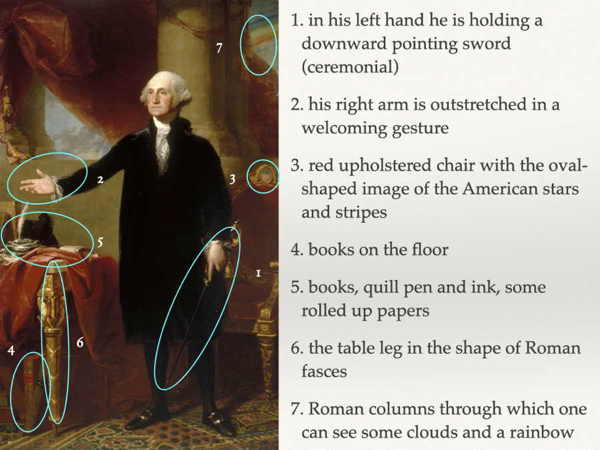
Things to Note:
- in his left hand he is holding a downward pointing sword
- his right arm is outstretched in a welcoming gesture
- behind him to the right is a red upholstered chair with the oval-shaped image of the American stars and stripes, a version of which appears in the Great Seal of the United States (1782)
- large books on the floor suggesting he has been at work
- two more books are on the table next to a quill pen and ink, some rolled up papers, and a black feathered hat
- the table leg in the shape of Roman fasces with what look to be eagles sitting on top
- there are Roman columns through which one can see some clouds and a rainbow which arches up from just above his right elbow to the top right
Jacques-Louis David, "The Emperor Napoleon in His Study at the Tuileries" (1812)↩
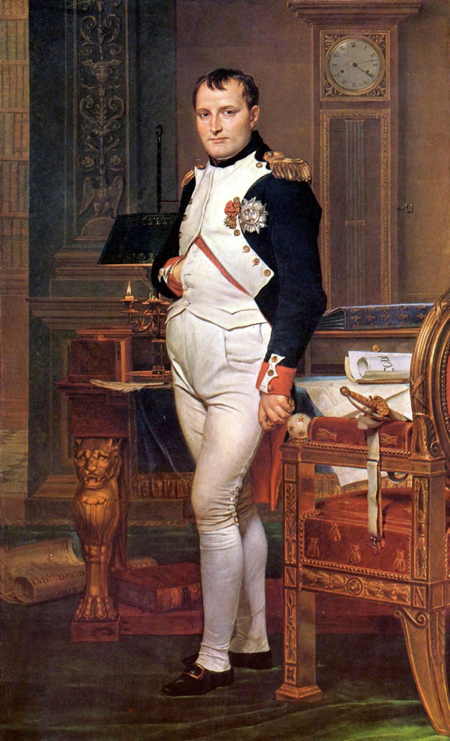
[See a larger version of this image (900px).]
Painting
Jacques-Louis David, "The Emperor Napoleon in His Study at the Tuileries" (1812).
Source
The National Portrait Gallery, Smithsonian Institution, Washington, D.C. [Online elsewhere] and Wikipedia [Online elsewhere]
Description
Emperor Napoleon is standing in his study after having worked all night on developing the Civil Code (which was promulgated in 1804). His hair appears to be messed up and he sports a five o’clock shadow (or in this case a “four o’clock shadow”). He is dressed in the military uniform of the Foot Grenadiers of the Imperial Guard with the Legion of Honour medal which he had awarded to himself. His right hand is tucked into his jacket and in his left hand he seems to be holding a gold object, perhaps an official seal. In the background to his left there is a grandfather clock which shows the time of 4.13 (possibly a.m.) and an upholstered chair upon which is laid his sword. The upholstery shows the imperial bee design; the initial “N” has been carved into the wood and the curved back of the chair is carved in the design of the Roman fasces. On the table is a pile of papers, one of which has the word “code”. To his right is a wall decoration which has the winged head of the Roman god Mercury (the messenger and the god of trade) and an imperial eagle. Immediately below that there is a candle which has nearly burnt to the end of the wick suggesting that Napoleon had been working all night in his study on the Code. The table shows a leg in the design of a lion (possibly Egyptian) and underneath is a pile of books and some papers on which the painter David wrote his name and the date of the painting. One of the books is Plutarch’s Parallel Lives.
Analysis
Napoleon was First Consul of France (1799-1804) and then Emperor (1804-1815). In this painting he is shown as very much a “working emperor” having stayed up all night working on his reform of the French legal system (the “Napoleonic” or Civil Code which was promulgated in 1804). He has been consulting large legal books and possibly annotating the drafts of the code written by expert lawyers. He is dressed as a simple solider, avoiding the monarchical symbols and attire he wore in other paintings at the time of his coronation as Emperor in 1804 (compare François Gerard, Napoleon in his Coronation Robes (1804)). There is an understated theme of militarism and imperialism with the imperial eagle, the Roman fasces, the Egyptian lion, the copy of Plutarch’s Parallel Lives, and his simple military uniform and single medal. It seems that in 1812 (when this painting was painted), close to his defeat in Russia and the ultimate end of his Empire, Napoleon wanted to return to an earlier period and to depict himself as an enlightened reformer working on one of his greatest legacies to the French nation.
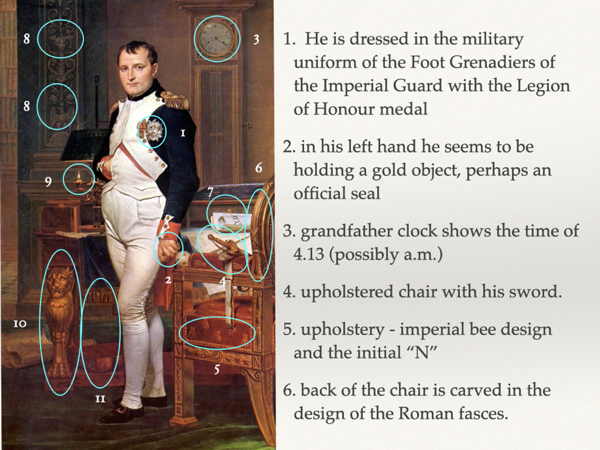

Things to Note:
- He is dressed in the military uniform of the Foot Grenadiers of the Imperial Guard with the Legion of Honour medal
- in his left hand he seems to be holding a gold object, perhaps an official seal
- a grandfather clock shows the time of 4.13 (possibly a.m.)
- there is an upholstered chair upon which is laid his sword.
- the upholstery shows the imperial bee design and the initial “N” has been carved into the wood
- the curved back of the chair is carved in the design of the Roman fasces.
- on the table is a pile of papers, one of which has the word “code” (the Civil or Napoleonic Code).
- a wall decoration which has the winged head of the Roman god Mercury (the messenger and the god of trade) and an imperial eagle.
- a candle which has nearly burnt to the end of the wick suggesting that Napoleon had been working all night in his study on the Code.
- the table shows a leg in the design of a lion (possibly Egyptian)
- a pile of books and some papers on which the painter David wrote his name and the date of the painting. One of the books is Plutarch’s Parallel Lives.
Some other American Presidents↩
Source: The White House Historical Association [Online elsewhere]
A selection of 20th and 21st century presidential portraits:
- Woodrow Wilson, 28th President of the United States, 1913-1921. Portrait by Frank Graham Cootes in 1936. Oil on canvas, 50 x 40 inches.
- Herbert Hoover, 31st President of the United States, 1929-1933. Portrait by Elmer Wesley Greene in 1956. Oil on canvas, 50 1/8 x 40 1/8 inches.
- Franklin D. Roosevelt, 32nd President of the United States, 1933-1945. Portrait by Frank O. Salisbury in 1947. Oil on canvas, 50 1/4 x 40 3/8 inches.
- John F. Kennedy, 35th President of the United States, 1961-1963. Portrait by Aaron Shikler in 1970. Oil on canvas, 50 x 34 inches.
- Gerald R. Ford, 38th President of the United States, 1974-1977. Portrait by Everett Raymond Kinstler in 1977. Oil on canvas, 40 x 34 inches.
- Ronald Reagan, 40th President of the United States, 1981-1989. Portrait by Everett Raymond Kinstler in 1991. Oil on canvas, 50 1/8 x 40 1/8 inches.
- Barack Obama, 44th President of the United States, 2009-2017. Portrait by Robert McCurdy in 2018. Oil on canvas, 53 3/4 x 48 inches.
- Kehinte Wiley's portrait of Barack Obama (2018)
- Donald Trump, 45th President of the United States, 2017-2021. Portrait by Shealah Craighead in 2017.
- photo for 2nd inauguration 2025
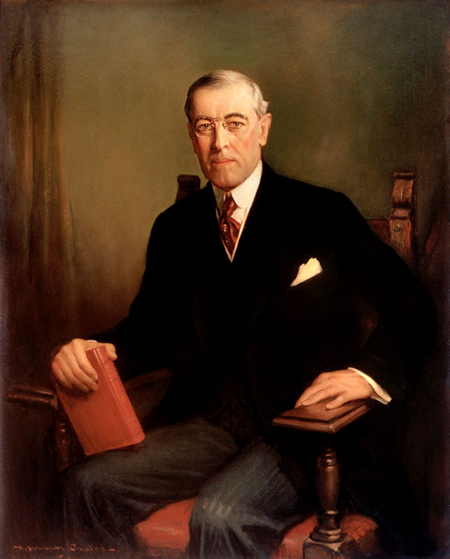
Woodrow Wilson, 28th President of the United States, 1913-1921
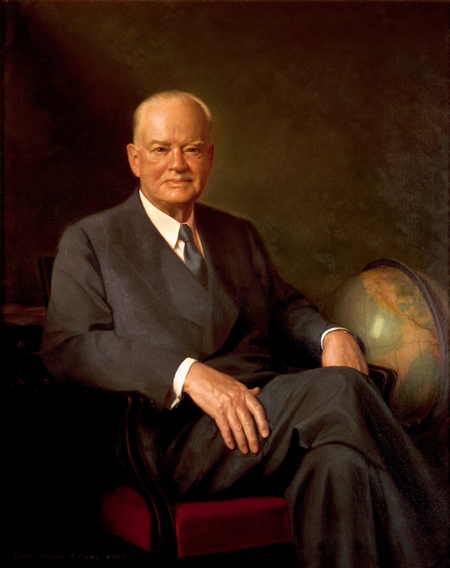
Herbert Hoover, 31st President of the United States, 1929-1933.
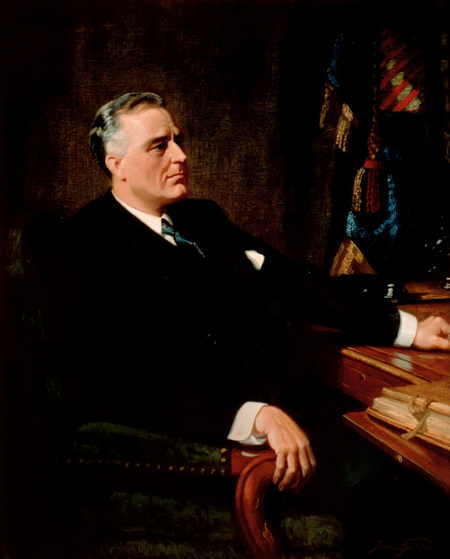
Franklin D. Roosevelt, 32nd President of the United States, 1933-1945.
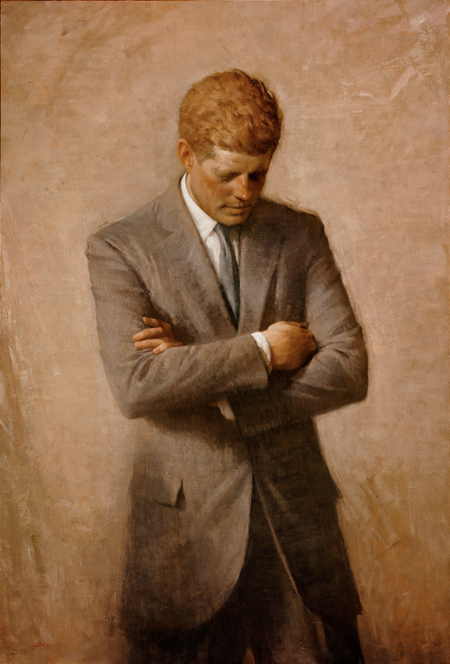
John F. Kennedy, 35th President of the United States, 1961-1963
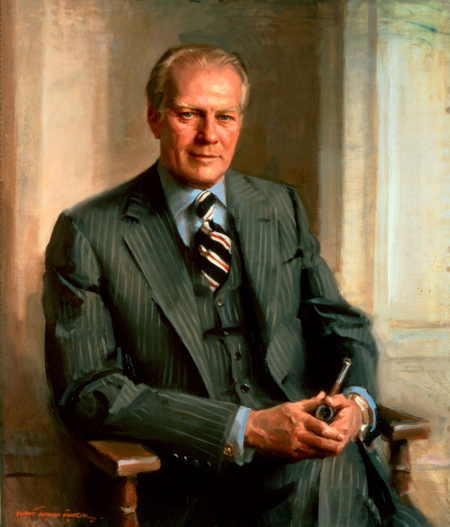
Gerald R. Ford, 38th President of the United States, 1974-1977
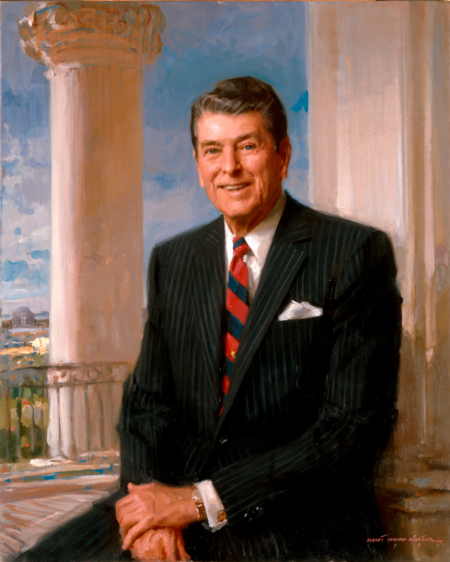
Ronald Reagan, 40th President of the United States, 1981-1989
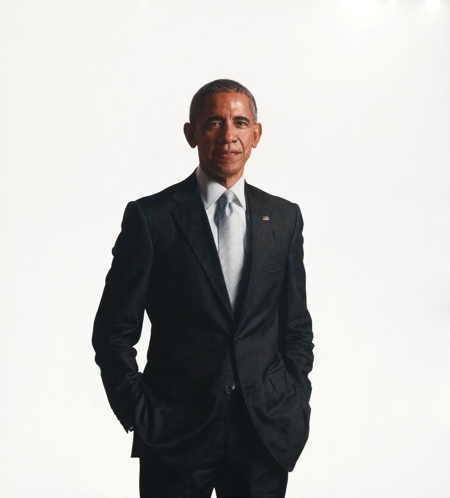
Barack Obama, 44th President of the United States, 2009-2017
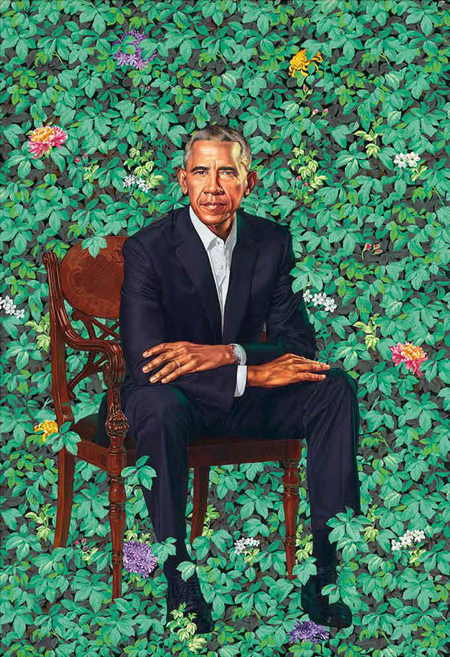
Kehinte Wiley's portrait of Barack Obama (2018)
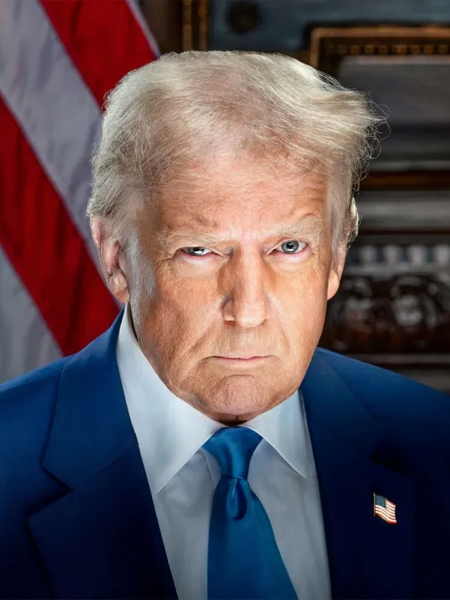
Official Portraits of Australian Prime Ministers↩
The Australian Parliament House hosts this collection and has it also online - "Portraits of Prime Ministers" [Online elsewhere].
It describes its function as:
After the end of each Australian Prime Minister's term in office, the Historic Memorials Collection (HMC) committee commissions prominent Australian artists to paint their portraits.
The portraits reflect how political leaders have chosen to be portrayed, and how they are viewed by the community. Early Prime Ministerial portraits tended to be intimidating, and larger than life. They often depict sitters in solemn poses, dressed in formal attire emerging from sombre surrounds. Over time, HMC artists have introduced a more personal dimension to the portraits, through the sitter’s pose, choice of backgrounds and inclusion of objects with personal associations.
Most of the portraits are very dull and sobre minded. Typical is Alfred Deakin (1856-1919), who was the first Attorney-General of the Commonwealth, and three times Prime Minister (1903-4, 1905-08, 1909-10). It was painted by the impressionist Australian painter Frederick McCubbin, "Alfred Deakin" (1914). [Online elsewhere]
There are however, some very interesting ones which reveal something about the politics and character of the sitters.
- Gough Whitlam (1916-2014) - PM 1972-1975. Painted by Clifton Pugh, "(Edward) Gough Whitlam (1972). It won the Archibald Prize in 1972 and was then purchased by the state. it looks like the modern art he controversially bought while in office (Jackson Pollock, "Blue Poles") [Online elsewhere]
- John Gorton (1911-2002) - PM 1968-1971. Painted by June Mendoz , "John Grey Gorton" (1971). This is the most relaxed looking PM, wearing a cravat, but leaning against a desk with some papers on it. [Online elsewhere]
- Paul Keating (1944-) - PM 1991-1996. Painted by Robert Lyall Hannaford, "Paul John Keating" (1997). He looks steely eyed, even a bit mischievous, he is elegantly dressed (gold tie, watch, cufflinks), his hands stand out as thin and meticulous. [Online elsewhere]
- John Howard (b. 1939) - PM 1996-2007. Painted by Jaiwei Shen, "John Winston Howard" (2009). He is wearing a suit and tie, in his office with a desk, and is the only one to have a flag in the background. [Online elsewhere]
- Tony Abbott (b.1957) - PM 2013-2015. Painted by Johannes Leak, "Tony John Abbott" (2022). His jacket off, he looks like a "man at work", in his office with books, family pictures, and a fire fighters helmet. [Online elsewhere]
- Kevin Rudd (b. 1957) PM 2007-10, 2013-2013. Painted by Ralph Heimans, "Dr Kevin Rudd AC" (2022). This is the symbolically richest portrait, in his study with books and art work, no tie or jacket, he is bearded, has a pen in hand as if in the middle of writing, there is cat and chess board on the desk. [Online elsewhere]
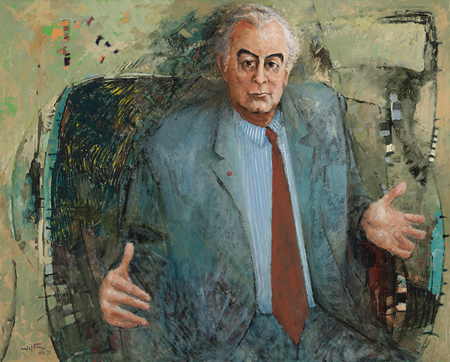
Gough Whitlam (1916-2014) - PM 1972-1975. Painted by Clifton Pugh, "(Edward) Gough Whitlam (1972).

John Gorton (1911-2002) - PM 1968-1971. Painted by June Mendoz , "John Grey Gorton" (1971).
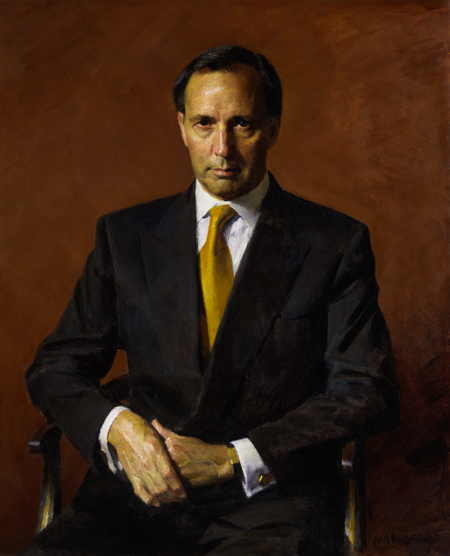
Paul Keating (1944-) - PM 1991-1996. Painted by Robert Lyall Hannaford, "Paul John Keating" (1997).
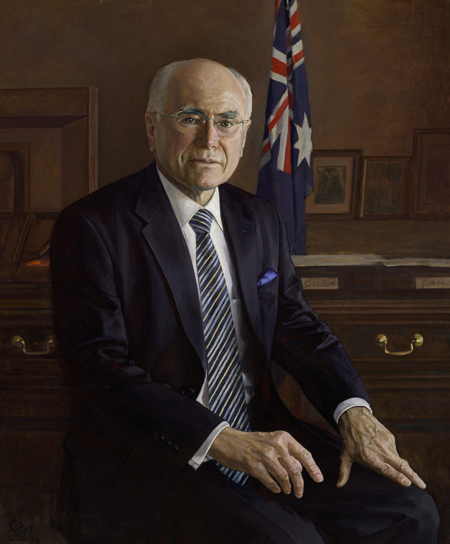
John Howard (b. 1939) - PM 1996-2007. Painted by Jaiwei Shen, "John Winston Howard" (2009).
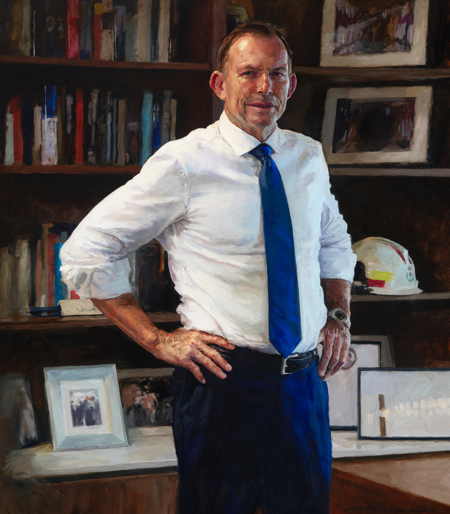
Tony Abbott (b.1957) - PM 2013-2015. Painted by Johannes Leak, "Tony John Abbott" (2022).
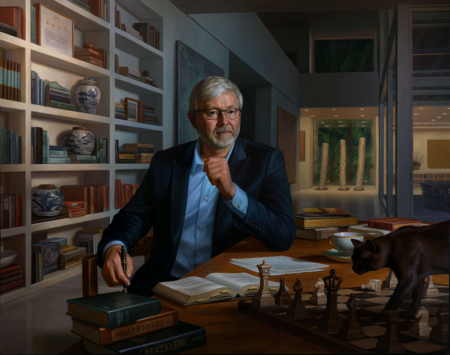
Kevin Rudd (b. 1957) PM 2007-10, 2013-2013. Painted by Ralph Heimans, "Dr Kevin Rudd AC" (2022).
Some Cartoons about Kings and Emperors and their Symbols of Authority↩
Some Cartoons drawn in Response to King Charles III's Coronation↩
For some light relief I thought it might be interesting and amusing to look at some cartoons which were drawn in response to the King Charles III's Coronation. I have tried to find cartoons which make use of some of the items we have looked at in this talk, namely the crown and the shoes.
- Barry Blitt, "King Charles III: A Modern Cinderella Story. The new monarch tries the crown on for size. A Perfect Fit" The New Yorker (September 16, 2022). [Online elsewhere]
- Marian Kamensky, "Big Shoes to Fill" Cartoon Movement "Coronation of King Charles III" [Online elsewhere]
- Cathy Wilcox, "Uneasy lies the Head", Museum of Australian Democracy at Old Parliament House. Coronation [Online elsewhere]
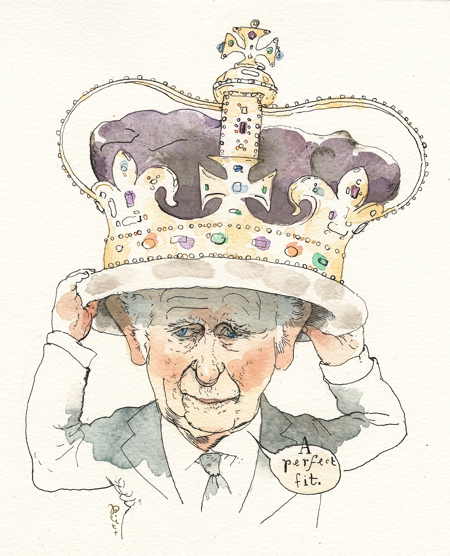
Barry Blitt, "King Charles III: A Modern Cinderella Story - A perfect Fit" (2022)
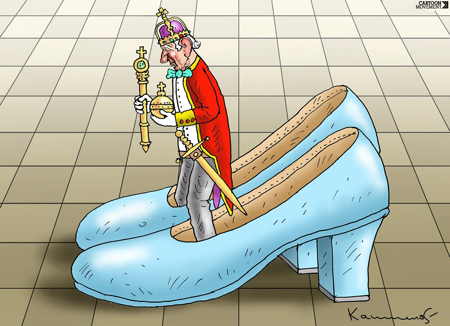
Marian Kamensky, "Big Shoes to Fill"
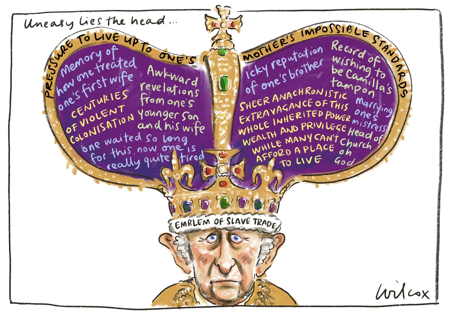
Cathy Wilcox, "Uneasy lies the Head"
Some Concluding Thoughts and Images about the "Emperor's New Clothes"↩
I have been looking at what people are wearing or where they are standing in order to find clues about the symbolic and political meaning of these things, what message the wearer is trying to send us concerning their authority, their legitimacy to wield that authority, and our obligation to obey that authority. Now and again someone comes to the conclusion that we can find out this information perhaps just as well by imagining that the powerful people involved are not wearing any clothes at. Here are a couple of examples.
The Australian cartoonist and illustrator Larry Pickering (1942-2018)
Larry Pickering (1942-2018) was a political cartoonist at The Canberra Times, the Sydney Morning Herald, and The Australian newspapers. For the latter he did the "Jungle Series" where politicians were jungle animals. Soon after he published his own annual calendar called "Pickering's Playmates" in which he skewered leading political figures and celebrities by drawing them in the nude and distorting their anatomy in order to make his points about their character and their behaviour. I cannot show you any examples here but I can show you the cover page which is innocuous and inoffensive.
Hans ChristianAnderson's story of "The Emperor's New Clothes" (1837)
Hans Christian Anderson (1805-1875) was a Danish writer best known for his fairly tales. One was "Kejserens nye klæder" (The Emperor's New Clothes) published in 1837. It is about a vain and gullible emperor who is conned by two men who claim to have invented a beautiful new kind of fabric which is invisible to people who are incompetent or stupid. As no one who sees their "work" wants to admit to being either, everybody goes along with the deception. When the emperor parades through the streets wearing his "new clothes" only an innocent child has the courage to say out loud what everybody else believes, the "The Emperor has no Clothes".
The following image comes from a Czech artist Cyril Bouda (1901-1984) who did the illustrations for a collection of fairy tales published in 1956. We see the overweight and naked emperor proudly and rather arrogantly walking down the street, with his head held high, under a canopy held aloft by his courtiers while ordinary people line the street looking on in shock and amazement. Note that the Emperor is wearing a periwig, a crown, a sceptre, an orb, and high heeled shoes and stockings. But no clothes.
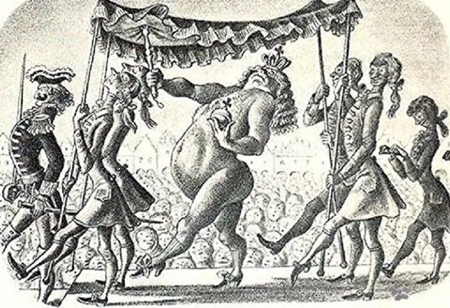
Cyril Bouda (1956)